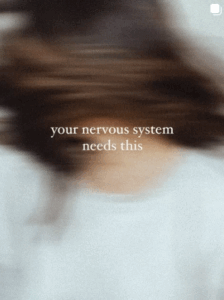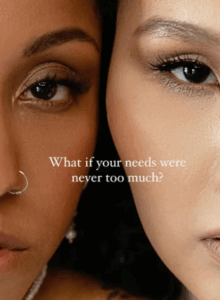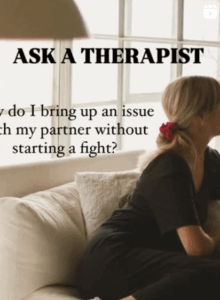At Existence Therapy, we meet so many clients who describe the same feeling: “I can’t relax. I feel like I’m always on edge.” Whether it’s lying awake replaying conversations, snapping over small things, or shutting down completely, this constant state of tension is often a sign of being stuck in fight-or-flight mode.
Laura, the founder of Existence Therapy, reminds clients that this isn’t a personal flaw — it’s the nervous system doing its best to protect you. But when survival mode runs the show, it can leave you exhausted and disconnected from yourself.
That’s why Laura encourages every client to create a Calm Toolkit: a personal collection of grounding practices that can help you return to balance when life feels overwhelming.
What Is a Calm Toolkit for Survival Mode?
Laura describes it as “a safety net for your nervous system.” Instead of powering through or waiting for stress to pass, you have simple, ready-to-go tools that remind your body and mind that you’re safe.
Your toolkit can be a small box, a pouch in your bag, or even a notes app on your phone. The key is making it personal and easy to reach for when you feel your stress rising.
Why Fight-or-Flight Needs Tools
When your nervous system gets triggered, it flips into survival mode — pumping out adrenaline, tightening your muscles, and sharpening your focus on danger. Helpful in emergencies, yes — but draining when it becomes your everyday state.
Laura explains it like this: “Imagine your body’s alarm system stuck on high volume. A Calm Toolkit helps you turn the dial back down so you can feel safe and present again.”
Laura’s Go-To Toolkit Practices
Here are some of the grounding tools Laura often suggests to her clients at Existence Therapy. You can pick a few that resonate and start building your own kit today.
1. Breathing Practices to Signal Safety
Breath is one of the fastest ways to reset fight-or-flight.
-Box Breathing (Laura’s favorite starter tool): Inhale for 4, hold for 4, exhale for 4, hold for 4. “It’s structured and simple — perfect for clients who feel scattered,” she says.
-4-7-8 Breathing: Inhale for 4, hold for 7, exhale for 8. Calms anxiety and helps with sleep.
-Soothing Sighs: Inhale deeply, then exhale with a slow sigh. Laura often models this in sessions to show how powerful a single sigh can be.
2. Gentle Movement to Release Stress
Laura emphasizes that survival mode lives in the body, so movement is essential.
-Shaking Practice: Stand and shake your arms, legs, and body for 30–60 seconds. “Animals shake after stress to discharge energy — humans can do the same,” she tells clients.
-Stretch Breaks: Roll your shoulders, tilt your neck, and reach your arms overhead. Laura suggests pairing this with a mindful breath.
-Grounding Walks: Focus on the feeling of your feet connecting with the earth. For clients who feel disconnected, Laura recommends silently repeating: “I am here, I am safe.”
3. Music as Nervous System Medicine
Music can regulate mood faster than words.
Laura encourages clients to create three playlists:
-Calm Playlist: soft instrumentals or acoustic songs to ease anxiety.
-Release Playlist: upbeat music that invites you to dance or move emotions through.
-Comfort Playlist: nostalgic songs tied to safe memories.
“When you’re too overwhelmed to think of what helps, having these playlists ready can be a lifeline,” Laura says.
4. Sensory Grounding
Engaging the five senses helps anchor you back in the present.
Laura’s favorite quick tool is the 5-4-3-2-1 Method:
-Name 5 things you see.
-4 things you feel.
-3 things you hear.
-2 things you smell.
-1 thing you taste.
She often suggests clients keep a textured object (like a smooth stone or soft fabric) or a calming scent (like lavender oil) in their toolkit.
5. Calming Reminders
In the middle of fight-or-flight, it’s easy to forget what helps. That’s why Laura recommends keeping short, written reminders in your toolkit. A few examples she gives clients:
-“Take three slow breaths.”
-“Step outside for fresh air.”
-“Drink a glass of water.”
-“Call someone safe.”
“It may seem simple, but sometimes that one gentle reminder is all your nervous system needs,” Laura explains.
How to Know If You’re in Survival Mode
Laura often helps clients recognize when fight-or-flight is running the show. Some common signs:
-Always feeling tense or “on guard.”
-Trouble sleeping or feeling tired but wired.
-Snapping over little stressors.
-Feeling numb, joyless, or disconnected from your body.
If these resonate, your nervous system may be stuck in survival patterns — and that’s where tools like the Calm Toolkit can help.
What Coming Out of Survival Mode Feels Like
Clients often describe the shift as:
-Sleeping more deeply.
-Feeling lighter and calmer.
-Noticing joy in small things again.
-Responding to stress with more flexibility.
Laura shares: “The first sign for many clients is the ability to take a deep breath and feel it all the way down. That’s when they know their system is learning safety again.”
Did You Grow Up in Survival Mode?
For some, survival mode started in childhood. If your home was unpredictable, unsafe, or emotionally neglectful, your nervous system may have adapted by staying hypervigilant or shutting down.
Laura gently reminds clients: “Patterns learned in survival can be unlearned in safety. With practice, your nervous system can adapt and heal.”
Bringing Therapy Into the Toolkit
While a Calm Toolkit is powerful, Laura emphasizes it’s not a replacement for therapy. At Existence Therapy, sessions often include:
-Somatic Practices: helping clients notice and release stored stress.
-Mindfulness Work: guided grounding exercises tailored to each client.
-Talk Therapy with a Trauma-Informed Lens: exploring the root causes of survival mode while weaving in body-based tools.
Laura says, “The toolkit is your daily practice. Therapy is where we discover why your nervous system got stuck and how to guide it home again.”
Final Encouragement from Laura
Survival mode isn’t permanent. Your nervous system can change. By building a Calm Toolkit and practicing small daily grounding rituals, you begin retraining your body to trust safety again.
✨ “Even if all you do today is take one deep breath or listen to one calming song, that’s a step out of survival mode,” Laura reminds her clients. “Healing is built in these small, steady moments of safety.”

You don’t have to hold it all together here.
Hi, I’m Laura—a trauma-informed psychotherapist supporting individuals and couples across Ontario. I help those who grew up without emotional safety reconnect with themselves, their bodies, and their relationships.
Many of my clients are the people-pleasers and overthinkers who seem capable on the outside but feel exhausted and “not enough” inside. If that sounds familiar, you don’t have to carry it alone.
Let’s Begin.
If you’re ready to explore what healing could look like – not through fixing, but through feeling, remembering, and reconnecting – I’d be grateful to be part of that process.
Still unsure? We're here to help.
Totally fair to have questions. That’s why we created a full FAQ Centre with real, straightforward answers to things you’re probably already searching—like how online therapy actually works, what your first session might look like, how we match you with a therapist, and how to get started if you’re new to all of this.
Here are a few quick answers to get you going:
A meaningful and supportive therapy journey is ready when you are.
Meet Laura, the founder and therapist at Existence and connect in for free 15-minute intro session. Simple, supportive, and no pressure to commit.
- Professional
- Inclusive
- Curated





Join us @existencetherapy


